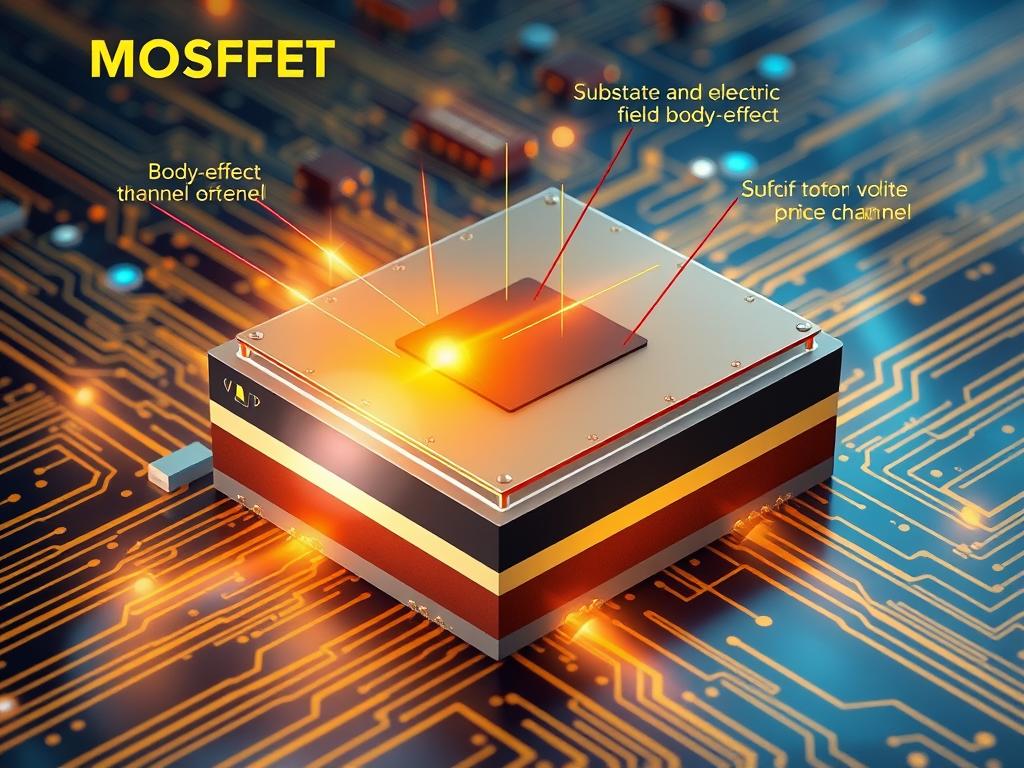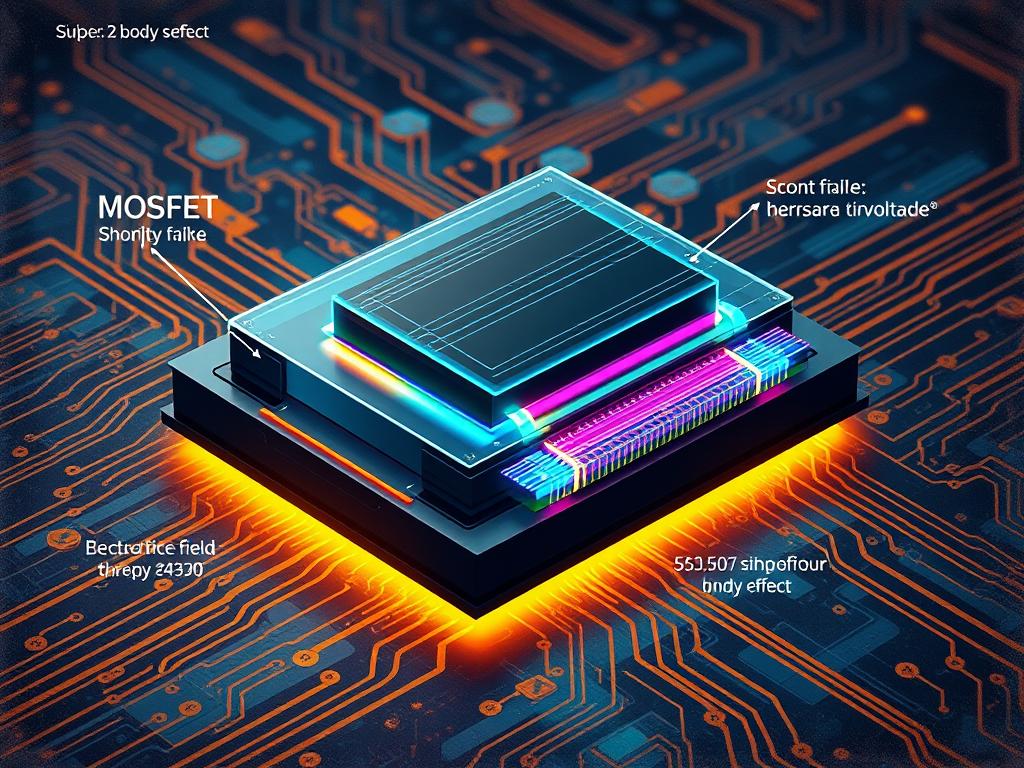In the world of electronics, MOSFETs have become key players, surpassing BJTs in many areas. They are found in huge numbers in memory chips and microprocessors. Knowing how they work is vital for those in the field. The body effect in MOSFETs is one important aspect to grasp, as it affects their performance.
Key Takeaways
- The body effect in MOSFETs refers to the impact of the substrate bias on the device’s threshold voltage and behavior.
- Understanding the body effect is crucial in low-voltage applications and integrated circuits where the body is common to multiple transistors.
- The body effect is described by the equation VTH = VTHO + γ(√(|2φF + VSB|) – √(|2φF|)), where γ is the body effect coefficient and VSB is the source-to-bulk voltage difference.
- The body effect can cause changes in the depletion region and channel depth, ultimately affecting the MOSFET’s threshold voltage and characteristics.
- Proper understanding and mitigation of the body effect are essential for optimizing MOSFET-based circuit design and performance.
Understanding the Basics of MOSFETs
Metal-Oxide-Semiconductor Field-Effect Transistors (MOSFETs) are key in today’s electronics. They power many things, from digital circuits to power systems. MOSFETs are better than some other devices because they use less power, have high input impedance, and are very versatile.
What is a MOSFET?
A MOSFET is a three-terminal device made of metal, oxide, and semiconductor. It has a source, drain, and gate. When you apply a voltage to the gate, it controls the current flow between the source and drain. This makes it useful as a switch or amplifier.
The MOSFET works by creating an inversion layer in the channel. This layer lets the device work in different modes.
Key Components of a MOSFET
The main parts of a MOSFET are:
- Source (S): Where charge carriers start
- Drain (D): Where charge carriers end
- Gate (G): Controls the flow of charge carriers
- Body (B): The base semiconductor, often tied to the source
How MOSFETs Work
MOSFETs work by using a voltage on the gate to control current flow. This voltage creates an electric field. It either makes the channel region more conductive or blocks it.
MOSFETs can act as both switches and amplifiers. This makes them very useful in electronic circuits.
Knowing about MOSFET fundamentals, like Channel Length Modulation and Subthreshold Behavior, is key. It helps in making better MOSFET-based circuits. As technology grows, MOSFETs will keep playing a big role in electronics.
Definition of Body Effect
In the world of Metal-Oxide-Semiconductor Field-Effect Transistors (MOSFETs), the body effect is key. It affects how these devices work and perform. The body effect changes the threshold voltage of a MOSFET. This happens because of the voltage difference between the source and bulk (or substrate) terminals.
What is the Body Effect?
The body effect makes the threshold voltage of a MOSFET change. This change happens because of the voltage difference between the source and the bulk (or substrate) terminals. This difference can occur in circuits where the source voltage is not the same as the substrate voltage. It can alter how the device behaves and performs.
Importance of Body Effect in MOSFET Operation
Knowing about the body effect is vital for making efficient MOSFET-based circuits, especially in low-voltage applications. The body effect can greatly affect the threshold voltage, transconductance, and drain current of a MOSFET. This can change its overall performance. It’s important to understand the body effect well to design MOSFETs that work as expected in different electronic systems.
| Parameter | Impact of Body Effect |
|---|---|
| Threshold Voltage (Vth) | The threshold voltage changes due to the voltage difference between the source and bulk terminals. |
| Transconductance (gm) | The transconductance, which relates the gate-source voltage to the drain current, is influenced by the body effect. |
| Drain Current (ID) | The drain current of the MOSFET is affected by the changes in threshold voltage caused by the body effect. |
By understanding the body effect and its impact on MOSFET operation and threshold voltage, designers can improve their electronic circuits and devices. This ensures they work reliably and efficiently.

Mechanisms Behind the Body Effect
The body effect in MOSFETs is tied to the voltage on the body terminal. This voltage changes the width of the depletion region. As the body voltage drops, the depletion region gets wider, raising the threshold voltage (Vt).
The Role of the Body Terminal
The body terminal is key in MOSFETs. The voltage on it, called the body bias voltage (VSB), controls the depletion region’s width. When this voltage goes down, the depletion region grows, making it harder to turn the device on.
Impact on Threshold Voltage
The body effect changes the threshold voltage (Vt) by affecting the depletion charge (Qdep). As the body bias voltage drops, the depletion region gets wider. This increase in depletion charge raises the threshold voltage needed to activate the MOSFET.
| Parameter | Description |
|---|---|
| W | Channel width |
| L | Channel length |
| u | Mobility |
| COX | Gate oxide capacitance |
| Vt0 | Threshold voltage |
| lambda | Channel-length modulation parameter |
| g | Transconductance parameter |
| 2ff | Substrate bias effect coefficient |
Impact of Body Effect on Device Characteristics
The body effect in Metal-Oxide-Semiconductor Field-Effect Transistors (MOSFETs) greatly affects transconductance and drain current. These changes are key to consider when designing and analyzing circuits.
Changes in Transconductance
The body effect changes a MOSFET’s ability to amplify or control electrical signals. When the body-source voltage goes up, the MOSFET’s threshold voltage also increases. This rise in threshold voltage lowers the device’s transconductance. This affects its gain and performance in circuits.
Variations in Drain Current
The body effect also affects the drain current of a MOSFET. The increase in threshold voltage changes the device’s current-voltage (I-V) characteristics. This results in less drain current available. This can impact the power use and efficiency of digital circuits and the quality of analog applications.
Understanding the body effect is vital for designing modern semiconductor devices. It helps engineers create high-performance, energy-efficient, and reliable electronic systems.
“The body effect is a critical factor in determining the overall performance and behavior of MOSFETs, and must be carefully accounted for in circuit design and analysis.”
Factors Influencing the Body Effect
The body effect in MOSFETs is affected by two main factors: substrate bias voltage and channel dimensions. Knowing how these elements influence MOSFETs is key for designing and optimizing MOSFETs.
Substrate Bias Effects
The substrate bias voltage (VSB) changes the threshold voltage in a MOSFET. When the substrate bias goes up, the threshold voltage also increases. This makes the body effect more noticeable.
This relationship is shown in the formula: Vt = Vt0 + γ(√(Φs + VSB) – √Φs), where Vt0 is the threshold voltage at VSB = 0, γ is the body effect coefficient, and Φs is the surface potential at threshold.
Channel Dimensions
The length and width of a MOSFET’s channel also affect the body effect. Shorter channels are more sensitive to the body effect. This is because the drain-induced barrier lowering (DIBL) effect is more significant.
The threshold voltage equation for this case is: Vt = Vt0 + γ(√(Φs + VSB) – √Φs) – ηVDS, where η is the DIBL coefficient. The channel length modulation (CLM) parameter, λ, also affects the current in the saturation region.
By understanding Substrate Bias Effects and Channel Dimensions, MOSFET designers can improve performance. This reduces the body effect, leading to better reliability and efficiency in various applications.
Modeling the Body Effect
Understanding the body effect is key to designing analog and digital circuits. This effect, also known as the back-gate effect, changes a MOSFET’s threshold voltage. It happens when there’s a nonzero voltage between the source and body. There are two main types of models for this effect: static and dynamic models.
Static vs. Dynamic Models
Static models show how a MOSFET behaves at a single point. They use the threshold voltage equation, which includes the body effect. On the other hand, dynamic models track how a MOSFET changes over time.
Common Equations for Representation
The threshold voltage equation is a common way to show the body effect. It includes a term for the Charge Sharing Model. This model shows how the body terminal affects the channel length and threshold voltage. More advanced models also consider the surface potential and its relation to the body bias.
| Model Type | Characteristic | Equations |
|---|---|---|
| Static | Threshold Voltage | Vth = Vth0 + γ(√(Vsb + 2ϕf) – √(2ϕf)) |
| Dynamic | Surface Potential | ψs = 2ϕf + Vsb + (2εsqNa(2ϕf + Vsb))^0.5 / Cox |
| Charge Sharing | Channel Length Modulation | Ids = (μnCox/2)(W/L)(Vgs – Vth)^2(1 + λVds) |
These models and equations are vital for accurate circuit simulation and analysis. They ensure the body effect is correctly considered in design.

Applications of MOSFETs with Body Effect
Metal-Oxide-Semiconductor Field-Effect Transistors (MOSFETs) are key in many electronic circuits. They are used in digital, analog, and power management systems. The body effect makes MOSFETs special for certain uses.
Digital Circuits
In digital circuits, the body effect affects how MOSFETs switch on and off. It changes the threshold voltage, impacting timing and performance. Designers must consider this to ensure reliable digital operation.
Analog Applications
Analog design needs a good grasp of the body effect for signal processing and amplification. The body effect changes MOSFETs’ transconductance and drain current. These changes are vital in analog circuits like amplifiers and filters. Designers must account for the body effect to keep performance high.
Power Management
In power management, the body effect is crucial. It helps in designing better voltage regulators and current controllers. By understanding the body effect, designers can improve the efficiency of these circuits.
| MOSFET Applications | Impact of Body Effect | Key Considerations |
|---|---|---|
| Digital Circuits | Affects switching characteristics and timing | Ensure reliable digital operation by accounting for body effect |
| Analog Design | Alters transconductance and drain current | Maintain linearity, gain, and other essential analog performance metrics |
| Power Management | Leveraged for efficient voltage regulation and current control | Optimize performance and efficiency of power management circuits |
Understanding the body effect helps in designing better electronics. It allows for robust digital circuits, high-performance analog systems, and efficient power management solutions.
Techniques to Minimize Body Effect
The body effect in MOSFET devices can greatly affect their performance. It can change the threshold voltage and other important characteristics. Luckily, there are ways to reduce the body effect and improve MOSFET performance.
Use of Differential Pair Techniques
Using differential pair techniques is a good way to fight the body effect. These techniques work by canceling out the common-mode body effect. This leads to better device performance and stability.
Designing with Proper Substrate Connections
Designing with the right substrate connections is also key. Connecting the bulk (or substrate) of the MOSFET to the source terminal can remove the body effect. But, this method might add layout and fabrication challenges that need careful thought.
| Technique | Description | Advantages | Limitations |
|---|---|---|---|
| Differential Pair Techniques | Leveraging the differential nature of analog circuits to cancel out common-mode body effect influences | Improved device performance and stability | Requires specific circuit topologies and design considerations |
| Proper Substrate Connections | Tying the bulk (or substrate) of the MOSFET to the source terminal to eliminate the body effect | Effectively eliminates the body effect | May introduce layout and fabrication constraints |
By using these methods, electronics experts can lessen the body effect’s impact. This leads to more reliable and efficient MOSFET-based circuits. Careful planning of these strategies can enhance device features, boost power efficiency, and improve system performance.
“Proper understanding and implementation of body effect minimization techniques are crucial for achieving optimal MOSFET performance in modern electronic designs.”
Body Effect in Different MOSFET Types
The body effect shows up differently in enhancement mode and depletion mode MOSFETs. Knowing these differences is key for picking the right device and designing circuits for various electronic needs.
Enhancement Mode MOSFETs
Enhancement mode MOSFETs are off by default. They need a positive gate-source voltage to start conducting. The body effect makes the threshold voltage go up when a negative voltage is applied to the body terminal.
This makes it harder to turn the device on. It can also affect how well the circuit works and stays stable.
Depletion Mode MOSFETs
Depletion mode MOSFETs, on the other hand, are always on and can carry current without a gate-source voltage. The body effect in these MOSFETs can lower the threshold voltage. This means it might take less voltage to turn the device off.
This is something to think about when designing circuits with depletion mode MOSFETs. It can change how the circuit works and performs.
The way the body effect works in enhancement mode and depletion mode MOSFETs shows why it’s important to know each type’s unique traits. By understanding these differences, electronics experts can make better choices when picking and designing MOSFET-based circuits. This ensures their systems work well and reliably.
Measurement Methods for Body Effect
Understanding the body effect in MOSFETs is key for making better electronic circuits. Scientists have come up with different ways to measure and study this important transistor phenomenon.
Experimental Approaches
One main way to measure the body effect is by looking at how a MOSFET’s threshold voltage changes. This happens when you change the voltage on the body or substrate terminal. Engineers can see how the device’s switching behavior changes, which shows the body effect.
Simulation Tools
MOSFET simulation tools are also vital. They use detailed models of the body effect to help designers predict how devices will perform. This is crucial for making high-quality analog and digital circuits.
Both using experiments and simulation tools are important for fully understanding the body effect in MOSFETs. By combining these experimental methods and MOSFET simulation techniques, engineers can make sure their circuits work well and reliably in many electronic devices.

Case Studies on Body Effect Performance
The body effect in MOSFETs is key to their performance in real-world circuits. It’s especially important in switching applications and amplifier design.
Switching Applications
In switching, the body effect affects how fast MOSFETs turn on and off, and how much power they use. Forward body bias makes them turn on quicker but can cause more leakage. Reverse body bias makes them turn on slower but leaks less. Managing the body effect is crucial for better switching and power use.
Amplifier Design
In amplifiers, the body effect impacts gain and linearity. Amplifiers need to manage the body effect to keep performance high. Ignoring it can harm the amplifier’s performance and stability.
These examples show how vital it is to understand and manage the body effect in circuit design. By doing so, engineers can improve performance, power use, and reliability. This ensures their designs meet today’s high standards.
| Parameter | Impact of Body Effect |
|---|---|
| Switching Speed | Forward body bias reduces turn-on time, but increases leakage current. Reverse body bias increases turn-on time but decreases leakage. |
| Amplifier Gain | Body effect can alter the transconductance of the MOSFET, affecting the overall gain of the amplifier circuit. |
| Power Consumption | Improper body bias conditions can lead to increased power dissipation and thermal management challenges. |
| Reliability | Extended reverse body bias stress can degrade device performance over time, reducing the lifecycle and reliability of the circuit. |
“Accurate and fast validation of body bias conditions is essential for meeting high performance and low power requirements in complex designs.”
Future Trends in MOSFET Technology
The electronics world is always changing. Researchers and engineers are working hard to solve the body effect in MOSFETs. They want to improve MOSFET Technology Trends, reduce the Body Effect, and boost Device Performance Enhancement. This is to meet the growing need for better and more efficient electronics.
Emerging Techniques to Counter Body Effect
One new method is advanced substrate engineering. It uses special materials and structures to lessen the body effect’s impact. For instance, strained silicon technology helps improve n-type MOSFETs’ source injection velocity. This makes devices work better.
Another new technique is the creation of novel device structures, like gate-all-around (GAA) transistors. These 3D thin-body architectures improve electrostatic control. This leads to less short-channel effects and body-related problems.
Prospects for Enhanced Device Performance
Thanks to Moore’s Law, semiconductor technology keeps getting better. This has led to:
- Less power use with lower supply voltages and better power efficiency
- Quicker switching speed and frequency thanks to scaling and innovation
- Better current density and transconductance
- More devices packed into each chip
The industry’s drive for these improvements, along with new tech like 2D semiconductors and negative-capacitance field-effect transistors (NCFET), is exciting. It promises a bright future for MOSFET technology.

“The price of one bit of semiconductor memory dropped 100 million times in the past forty-five years since 1965, marking an unmatched engineering achievement in human history.”
As we keep pushing MOSFET technology, these new solutions and advancements are key. They will power the next wave of efficient, high-performance electronic devices.
Conclusion
The body effect is very important in Metal-Oxide-Semiconductor Field-Effect Transistor (MOSFET) design. It affects the threshold voltage and how devices work. This is key for the performance and efficiency of electronic circuits and systems.
Recap of Key Points
In this article, we looked into the body effect in MOSFETs. We talked about what causes it, its effects on devices, and how to manage it. We also discussed its role in digital circuits, analog amplifiers, and power management systems.
Final Thoughts on Body Effect in MOSFETs
As semiconductor technology grows, managing the body effect is crucial. It’s important for improving MOSFET design and performance. Electronics experts need to understand and reduce its impact to make better devices. New materials and architectures, like FinFET and Gate-All-Around FET, are helping to overcome these challenges.


